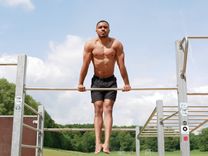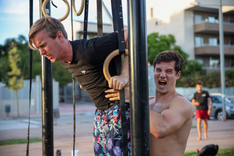Unlocking the Power of Muscle-Ups: Your Ultimate Guide to Mastering, Benefiting, and Tackling Muscle-Ups for All

Discover the magic behind the muscle-up, a phenomenal compound exercise that showcases the pinnacle of upper body strength and control. This versatile and challenging movement has taken the fitness world by storm, captivating athletes and enthusiasts alike. In this comprehensive guide, we'll unravel the secrets of muscle-ups, explore their incredible benefits, and help you understand the unique demands of performing them on gymnastic rings. Whether you're a beginner or an advanced athlete, this in-depth exploration will empower you to conquer the muscle-up and elevate your fitness journey to new heights. Join us as we embark on this exciting adventure and learn how to master one of the most sought-after skills in calisthenics and functional fitness.
What is a Muscle-Up?
A ring muscle-up is an exercise where you pull your body up on gymnastic rings and then push yourself up, so your arms are straight, and your chest is above the rings. It combines a pull-up and a dip, working your upper body muscles and challenging your strength and balance.
The ring muscle-up is a complex movement that starts with a pull-up, transitions to a dip, and finishes with a ring dip. Here's a step-by-step description of the movement:
1. Start with a false grip
Hang from the rings using a false grip, with your wrists over the rings and your palms facing each other. This grip will make the transition from pull-up to dip easier.
2. Initiate the pull-up
Engage your lats, shoulders, and biceps to pull your body upwards toward the rings. Maintain a tight core and keep your legs together to ensure a stable and controlled movement.
3. High pull
As you continue to pull your body upward, aim to bring your chest as close to the rings as possible. This will help create a smoother transition to the dip phase. At the top of the pull-up, your elbows should be close to your body, and your hands should be at your chest or armpit level.
4. Transition
At the peak of the pull-up, begin to shift your body weight forward by driving your elbows back and down while maintaining the false grip. Keep your chest close to the rings as you rotate your shoulders and transition your body over the rings. During this transition, your hands will move from being in front of your chest to a position supporting your body weight underneath your chest.
5. Begin the ring dip
As you complete the transition, you'll find yourself in the bottom of a ring dip position, with your chest above the rings, your elbows bent, and your hands supporting your body weight. Make sure your elbows are close to your body and your wrists remain in the false grip position.

6. Press up to finish
Engage your triceps, shoulders, and chest muscles to press your body upwards, extending your arms until they're fully straight. At the top of the dip, your arms should be locked out, and your body should be in a stable, controlled position above the rings.
7. Lower yourself back down
To complete the movement, lower yourself back through the dip and transition phases in a controlled manner until you return to the starting hanging position. This will help you develop the strength and control needed for multiple muscle-ups.
Remember to practice each step and build the necessary strength, stability, and technique to execute the movement smoothly and safely.
Where can I perform a muscle up? What do I need for it?
Unleash your inner athlete and conquer the impressive muscle-up at a variety of locations! All you need is a sturdy horizontal bar or a set of gymnastic rings to defy gravity and showcase your strength. Whether you choose to take on this challenge at a well-equipped gym, an outdoor calisthenics park, or even a robust tree branch, the world is your playground. Ensure that the apparatus you select is secure and has ample overhead clearance to accommodate the full range of motion for the muscle-up. Remember, the key to this exhilarating feat lies in combining power, technique, and determination, so gear up and get ready to soar to new heights with the mighty muscle-up!
Are muscle ups harder on rings?
Muscle-ups are challenging exercise that requires both strength and technique. While this movement can be performed on both a pull-up bar and gymnastic rings, many athletes find muscle-ups to be more difficult on rings. This is primarily due to the instability of the rings, which demands greater control and balance from the practitioner. Additionally, the grip required for ring muscle-ups is different from that on a bar, as it involves a false grip that engages the wrists and forearms more intensely. However, some athletes argue that perform ring muscle-ups allow for a more natural range of motion, which can make the movement feel smoother and more comfortable. Ultimately, the difficulty of muscle-ups on rings largely depends on an individual's experience, skill level, and personal preferences.

How do you train for your first ring muscle up?
Training for the first ring muscle-up can be a rewarding and transformative journey, and using a structured program can greatly enhance your progress. One such program, the DIE RINGE App, offers an organized and systematic approach to mastering this advanced movement. To prepare for a ring muscle-up, it's essential to build foundational strength in your upper body, focusing on exercises such as pull-ups, dips, and push-ups. Additionally, core stability and control are vital for seamless transitions between movements. The DIE RINGE App can help guide you through these exercises and provide progressions tailored to your skill level. By following a well-designed program like this, you'll be able to work on your technique and strength consistently, making your journey toward the perfect ring muscle-up smoother and more enjoyable.
Can I learn the Muscle Up as a woman?
Absolutely, women can learn and master the muscle-ups just like their male counterparts. While muscle-ups may be considered a challenging exercise, gender should not be a limiting factor in acquiring this skill. It is essential for women to focus on building upper body strength, particularly in the shoulders, chest, and back, as well as developing core stability and control. By incorporating specific exercises, such as pull-ups, dips, and push-ups, women can work progressively towards the muscle-up. Additionally, practicing the correct technique and utilizing progressions, like band-assisted muscle-ups, can greatly aid in learning this advanced movement. With dedication, consistent training, and proper guidance, women can undoubtedly achieve the muscle-up and showcase their strength and athleticism.

How high should rings be for muscle-ups?
Setting up the rings at the correct height is essential for performing muscle-ups safely and effectively. Ideally, the rings should be positioned high enough so that your feet do not touch the ground when you hang with fully extended arms. Additionally, ensure that there is ample overhead clearance to accommodate the full range of motion during the muscle-up. A helpful resource for learning how to properly attach and adjust the rings is the video from DIE RINGE.

This informative tutorial offers step-by-step guidance on setting up your rings for optimal performance, ensuring that you can train with confidence and safety. By following the expert advice from DIE RINGE, you'll be well-prepared to embark on your journey towards mastering the ring muscle-up.
Mastering Ring Muscle-Ups: A Comprehensive Guide to Conquering this Advanced Gymnastics Movement
Ring Muscle ups ares advanced gymnastics movemets that combines a pull-up and a dip on gymnastic rings. It requires a combination of upper body strength, stability, and technique. Here are the steps to learn a ring muscle-up:
1. Build foundational strength
With the following exercises you will build the necessary strength for the Muscle Up. Practice these exercises to get stronger and perfect your technique.
Pull-Ups:
Starting with a strong hang from a bar or rings, palms out, initiate pull-ups by engaging your core and pulling your shoulder blades down. As you pull up, aim for your chin to be above the bar, keeping your elbows close. After a brief pause at the top, return to the starting position slowly. Remember to maintain a tight core, full extension, and avoid using momentum. This strict form minimizes injury risk and enhances muscle engagement and strength.
Dips:
Start dips on rings with a firm support hold, arms extended, and core engaged. Lower your body slowly by bending your elbows until they reach a 90-degree angle. Keep elbows tucked in throughout for shoulder safety. Push back up, activating chest, triceps, and shoulders. Remember to keep your core strong, your elbows close, and control the movement to maximize muscle engagement and safety.
Ring Rows:
Start ring rows with an extended arm hold on the rings, body angled back, and feet firm. Keeping a straight body line, pull your chest towards the rings, leading with shoulder blades and elbows. After a brief pause at the rings, return slowly to the start. Key factors are to maintain a rigid body, lead with the shoulder blades, and avoid swinging or excessive momentum for targeted muscle engagement and safety.
Push-Ups:
Begin push-ups in a high plank position, hands wider than shoulders, body straight, and core tight. Bend your elbows to lower your chest towards the floor, maintaining a unified body line. Press upwards to the starting position, focusing on pushing the floor away. Key points are maintaining a tight core, tucking elbows close, and ensuring a controlled movement for maximal muscle engagement and safety.
2. Improve grip and false grip
Grip strength: Practice hanging from the rings and develop a strong grip.
False grip: Learn the false grip technique, which is crucial for the muscle-up transition. Hang from the rings with your wrists over the rings and practice holding this position.

Read more about wrist training!
Want to strengthen your wrists? The 4 best exercises for more mobility and stability!
3. Practice transition drills
Feet-assisted transition: With your feet on the ground, practice the transition from a pull-up to a dip while maintaining the false grip.
Band-assisted transition: Use a resistance band to provide assistance while practicing the muscle-up transition.
4. Strengthen the pull-up and dip components
High pull-ups: Focus on pulling your chest to the rings, which will help with the muscle-up transition.
Deep dips: Strengthen the top portion of the dip by performing deep dips on the rings.
5. Muscle-up negatives
Starting position is a ring dip position and lower yourself through the transition into a hang. This will help develop strength and control in the muscle-up movement.
6. Put it all together
Once you have developed the strength and technique for each component, attempt the full ring muscle-up. Use a kip or swing if needed to generate momentum.
7. Refine and practice
Continue to practice and refine your technique, focusing on smooth transitions and strict form. Gradually reduce the amount of kipping and work towards performing strict ring muscle-ups.

Master the Muscle-Up with DIE RINGE App: Elevate Your Strength and Athleticism
Unlock the true potential of your upper body strength and conquer the elusive muscle-up by downloading the DIE RINGE App today! With expert guidance, tailored progressions, and a systematic approach, this app will fast-track your journey toward a clean and powerful muscle-up. Don't let this challenging exercise remain a distant dream; make it a reality with the help of DIE RINGE App. So gear up, embrace the challenge, and embark on an exciting adventure that will transform your strength, athleticism, and confidence like never before.
Download the DIE RINGE App now
and witness the magic of a structured and efficient training program that will elevate you to new heights!